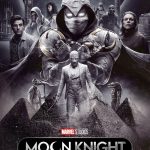Star Wars: A New Hope (1977)
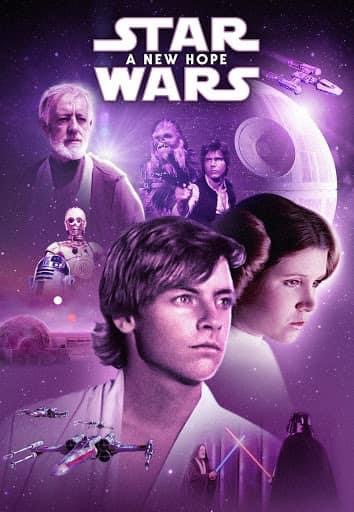
Star Wars: A New Hope (1977), directed by George Lucas, is not just a movie—it’s a cultural milestone that revolutionized cinema. As the first installment in the original Star Wars trilogy, it introduced audiences to a richly imagined galaxy filled with epic battles, memorable characters, and groundbreaking special effects, setting the foundation for one of the most enduring and influential franchises in film history.
Suggested videos for you:
Plot Overview
The story begins “a long time ago, in a galaxy far, far away,” where the evil Galactic Empire, led by Darth Vader, has seized control. Princess Leia, a leader of the Rebel Alliance, manages to steal the plans for the Death Star, a weapon capable of destroying planets. She hides these plans in the droid R2-D2, who escapes to the desert planet of Tatooine, where he crosses paths with a young farm boy named Luke Skywalker. Alongside his mentor, Obi-Wan Kenobi, smuggler Han Solo, and Chewbacca, Luke embarks on a mission to rescue Leia and destroy the Death Star, ultimately taking his first steps toward becoming a Jedi and discovering the power of the Force.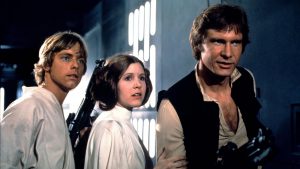
Characters and Performances
At the heart of A New Hope are its iconic characters. Mark Hamill’s portrayal of Luke Skywalker captures the character’s evolution from a wide-eyed farm boy yearning for adventure to a determined hero who discovers his greater destiny. His character is relatable in his naivety and dreams of escaping a mundane life for something more exciting and meaningful. Hamill’s portrayal perfectly conveys Luke’s growth and the beginning of his journey into a larger, dangerous world.
Harrison Ford’s Han Solo became an instant favorite with audiences due to his roguish charm, sarcastic wit, and unexpected depth. Initially self-serving and cynical, Han’s development from a smuggler into a hero shows his latent courage and loyalty to his friends, making him one of the most beloved characters in the series. Ford’s charisma and chemistry with the rest of the cast is one of the film’s highlights.
Carrie Fisher’s Princess Leia broke the mold of traditional female characters in adventure films. Leia is smart, brave, and assertive—she’s as much a leader in the fight against the Empire as any of the male characters. Fisher’s performance brought both strength and vulnerability to Leia, making her a groundbreaking figure for women in science fiction.
Alec Guinness as Obi-Wan Kenobi lends the film gravitas with his portrayal of the wise, world-weary Jedi Knight who introduces Luke—and the audience—to the Force. His calm, dignified presence provides a strong counterbalance to the film’s more action-oriented moments.
Darth Vader, portrayed by David Prowse with the voice of James Earl Jones, is one of cinema’s most iconic villains. His menacing presence, commanding voice, and mysterious connection to the Force set him apart from other film antagonists. Vader’s aura of fear and authority makes him a memorable and formidable force of evil, whose shadow looms over the entire series.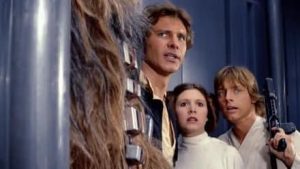
Story and Themes
Star Wars: A New Hope draws on classic mythological storytelling, particularly the “hero’s journey,” a narrative arc described by mythologist Joseph Campbell. Luke Skywalker’s transformation from a farm boy to a hero is the essence of this archetypal journey, complete with a call to adventure, mentorship from an elder figure, and a confrontation with a seemingly insurmountable enemy.
The film’s themes of good versus evil, destiny, and the importance of hope resonate universally. The Galactic Empire represents oppression and totalitarianism, while the Rebel Alliance symbolizes resistance and the fight for freedom. At a time when the world was grappling with the aftermath of war and political upheaval, A New Hope offered a timeless story of ordinary individuals standing up to overwhelming forces of darkness, reminding audiences of the power of hope and unity.
Another core theme is the mystical Force, an energy that binds the galaxy together. The Force symbolizes both spiritual awakening and the battle between light and dark, with Luke beginning his journey toward understanding this deeper power, while Vader represents its dangerous potential when corrupted.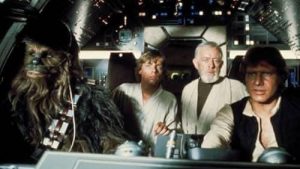
Visual Effects and Cinematography
Star Wars: A New Hope revolutionized special effects, setting new standards in the film industry. The movie’s groundbreaking use of miniatures, models, and practical effects to create the vastness of space, the Death Star, and the various ships—from the Millennium Falcon to the X-Wing fighters—was unlike anything seen before. The film’s visual effects, helmed by Industrial Light & Magic (ILM), transformed space battles and alien worlds into something both tangible and awe-inspiring.
The film’s use of sound also deserves mention. John Williams’ sweeping, now iconic score is integral to the film’s emotional power, enhancing both the grandeur of space and the intimate struggles of the characters. The music, particularly the heroic main theme, remains one of the most recognizable film scores in history, elevating the entire experience.
The lightsaber duels, though relatively simple in choreography compared to later installments, became an instant cultural symbol. The weapon itself, with its glowing blade and distinct humming sound, became one of the most iconic images of the Star Wars universe.
Cinematographer Gilbert Taylor’s work captures the desolate beauty of Tatooine’s desert landscapes, the cold, sterile interiors of the Death Star, and the epic space battles with a clarity and scale that fully immerses the audience. The film’s pacing is perfect—balancing action, character development, and moments of awe without ever losing momentum.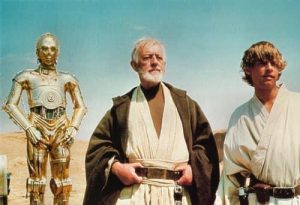
Legacy and Cultural Impact
The release of A New Hope was a turning point in film history. It became the highest-grossing film of its time, earning over $775 million worldwide, and created a fanbase that would grow into one of the most passionate and enduring in cinematic history. Its success spawned a sprawling franchise of sequels, prequels, spin-offs, TV shows, books, and merchandise, solidifying Star Wars as a cultural juggernaut.
But beyond the commercial success, A New Hope changed the way movies were made and marketed. It pioneered the modern blockbuster model, with an emphasis on special effects, merchandising, and sequels, and inspired a generation of filmmakers. From its use of innovative special effects to its immersive world-building, Star Wars laid the groundwork for many of the science fiction and fantasy films that followed.
Its influence extends beyond film. The film’s themes of rebellion against tyranny, the power of hope, and the journey of self-discovery resonate with audiences across generations and cultures. Characters like Luke, Leia, Han, and Vader have become archetypes in their own right, representing timeless human struggles and virtues.
Conclusion
Star Wars: A New Hope is more than just a movie; it’s a cultural touchstone that reshaped the landscape of popular entertainment. With its mix of classic storytelling, groundbreaking visual effects, unforgettable characters, and sweeping emotional scope, it continues to captivate and inspire audiences of all ages. Its legacy as one of the most beloved and influential films ever made is cemented, and it remains a must-watch for anyone interested in the power of cinema to transport and transform.



